On September 28, the US Fish and Wildlife Service (Service) approved removal of fall protections for Delta smelt that have been in place since 2008. The action allows south Delta pumping plants to export an additional 400,000 acre-feet of water on top of the 6.2 million acre-feet already exported through September in Water Year 2017. The water, earmarked for the Bay and Delta smelt, instead will go to southern California to fill reservoirs.
The action allows X2, the 2 parts per thousand salinity prescription, to be moved from Chipps Island (river kilometer 74) upstream to Collinsville (river kilometer 81). The action occurs simply by increasing south Delta exports, keeping all other factors constant (Figures 1 and 2). Exports have risen from 8,000 cfs to the maximum of 11,700 cfs. Delta net freshwater outflow to the Bay has fallen from 15,000 cfs to 10,000 with the higher exports and slowly falling Delta inflow (Figure 3). Salinity at Collinsville has nearly reached its new allowed level (Figure 4).
The effects of the higher exports can be seen in flows measured in Old River in the central Delta near Highway 4 (Figure 5). Flows through nearly the entire tidal cycle are negative as water rushes to meet the maxed-out exports in the south Delta. The daily average, also called OMR, is -5,000 cfs. Other channels, including the lower San Joaquin River, make up the remainder of the 11,700 cfs level of export.
The Service concludes that “the proposed Fall X2 action for 2017 would not adversely affect Delta Smelt” P5. They state that they see no evidence that the change will affect the smelt population. This is an incredible conclusion given the present state of the population (Figure 6). There is simply no basis for the conclusion other than saying the smelt are all gone anyway.
Reductions in Delta outflow, upstream movement of X2 into the western Delta, and negative net flows in any Delta channel are a direct and real threat to Delta smelt and their habitat (as the Service points out in its approval letter on page 8). In Reclamation’s request for the action, Reclamation frames the issue an adaptive management action within the context of the original 2008 biological opinion prescription. With the species on the brink of extinction, such negative “adaptive management” actions are not the logical approach to be taken toward recovery of the species. The prescription allowed adaptive management actions to help toward recovery, not to top off southern California reservoirs.
Sad thing is, 2017 is only the second year with hydrological conditions applicable to the 2008 fall X2 prescription. In 2011, the first and now only application of the prescription, the fall X2 requirement proved to contribute significantly toward recovery, as shown in the Fall Midwater Trawl Survey. I suspect there will be no similar “bounce” in the October-through-December survey index in 2017.

Figure 1. Tracy (federal) exports in September 2017.

Figure 2. Clifton Court (state) exports in September 2017.

Figure 3. Delta outflow to Bay in summer 2017.

Figure 4. Salinity (EC) at Collinsville (river kilometer 81) in September 2017.

Figure 5. Hourly flow in cfs in Old River in central Delta near Highway 4 crossing.

Figure 6. Delta smelt summer townet index 1969-2017. (CDFW data).

Figure 7. Fall midwater trawl index for Delta smelt
